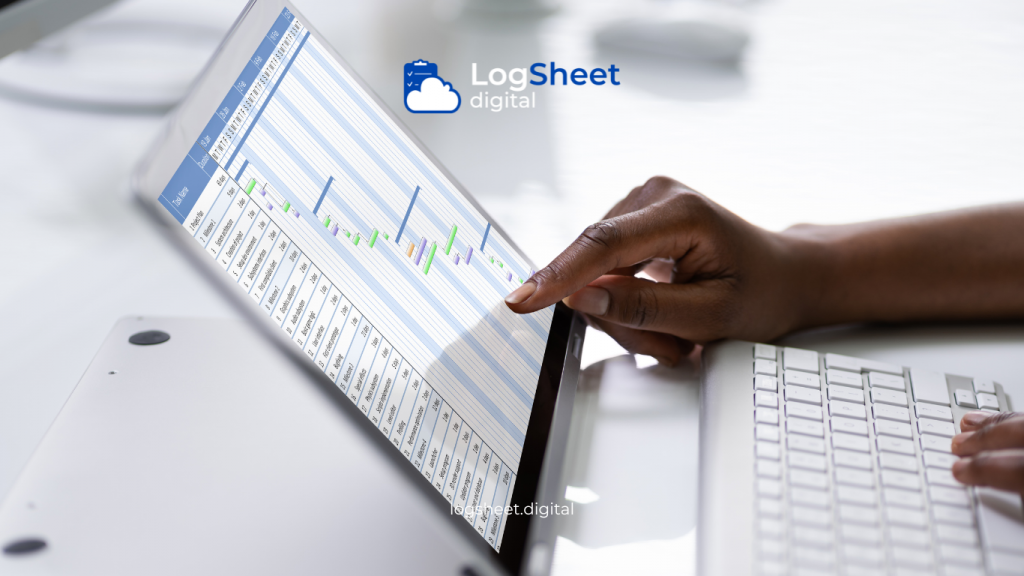In the current digital era, equipment and facility maintenance has become one of the crucial aspects for the operational continuity of a company. Ineffective maintenance can lead to significant losses, both financially and in terms of productivity. One of the innovative solutions increasingly implemented is the use of digital logsheets to replace traditional manual logsheets. The adoption of this technology is believed to improve efficiency, accuracy, and monitoring in the maintenance process.
What is a Digital Logsheet?

Read More: Data Security in Digital Logsheets: Challenges and Strategies
A digital logsheet is a technology-based system used to record, monitor, and analyze maintenance activities in real time. Unlike manual logsheets that use paper, digital logsheets utilize electronic devices such as tablets, smartphones, or computers to input and store data.
Digital logsheets are often integrated with a computerized maintenance management system (CMMS), allowing for the integration of various aspects of maintenance into one platform. This technology makes it easier for management to access maintenance data anytime and anywhere.
Benefits of Digital Logsheets in Maintenance

Read More: Sustainability in Safety: How Digital Logsheets Impact the Industry
1. Enhancing Operational Efficiency
The implementation of digital logsheets eliminates time-consuming manual processes, such as writing and filing paper-based data. With a digital system, data can be input quickly and automatically stored in the database.
2. Improved Data Accuracy
Human errors in data recording can be minimized with digital logsheets. Data input through electronic devices tends to be more accurate and valid due to automatic verification features.
3. Real-Time Monitoring
Digital logsheets allow for real-time monitoring of maintenance activities. Management can directly view the status of equipment and ongoing tasks through the available dashboard.
4. Easier Data Analysis
With digital logsheets, maintenance data can be analyzed quickly and efficiently. The collected data can be used to identify maintenance trends, predict failures, and plan preventive maintenance more effectively.
5. Reducing Operational Costs
The use of digital logsheets reduces the need for paper, ink, and storage space for files. Additionally, efficiency in the maintenance process can reduce costs related to damage and downtime.
Key Features in Digital Logsheets

Read More: Efficiency in Accident Reporting: Digital Logsheets in Safety Equipment
1. Integration with IoT Sensors
Digital logsheets can be integrated with Internet of Things (IoT) sensors to monitor equipment conditions automatically. These sensors provide real-time data on temperature, pressure, vibration, and other critical parameters.
2. Interactive Dashboard
Digital logsheets are equipped with interactive dashboards that make it easier for users to monitor all maintenance activities in one view. The dashboard presents visual reports that are easy to understand.
3. Notifications and Reminders
An important feature in digital logsheets is automatic notifications and reminders. This feature helps technicians and management remember scheduled maintenance tasks or detect equipment needing immediate attention.
4. Flexible Data Access
Digital logsheets allow data access anytime and anywhere through devices connected to the internet. This flexibility helps maintenance teams complete their tasks more efficiently.
5. Automatic Reports
The digital logsheets system can generate automatic reports in various formats. These reports help management make decisions based on accurate data.
Steps for Implementing Digital Logsheets

Read More: Digital Logsheets as an Operational Monitoring Tool for Warehouses and Logistics
1. Identify the Company’s Needs
Before implementing digital logsheets, the first step is to identify the company’s needs. Determine the goals for implementing digital logsheets, such as maintenance efficiency, improved data accuracy, or cost reduction.
2. Choose the Right Digital Logsheets Platform
Select a digital logsheet platform that suits the company’s needs. Ensure the system has required features, such as IoT integration, automatic notifications, and an interactive dashboard.
3. Train the Maintenance Team
Socialize the use of digital logsheets to the maintenance team. Provide training to ensure the technical team can use the platform effectively and understand its benefits.
4. Gradual Implementation
Implement digital logsheets gradually to minimize adaptation barriers. Start with a few units or pieces of equipment, then gradually extend it across the entire maintenance system.
5. Evaluation and Development
After implementation, conduct regular evaluations to ensure the system works as expected. Make improvements or upgrades as necessary.
Challenges in Implementing Digital Logsheets

Read More: Advantages of Digital Logsheets for Asset Maintenance Management
1. User Resistance
One of the main challenges is resistance from users who are accustomed to manual systems. The solution is to provide comprehensive education and training to support the transition to digital systems.
2. Implementation Costs
The initial investment for implementing digital logsheets might seem high, especially for small and medium-sized businesses. However, the long-term benefits outweigh these costs.
3. Connectivity and Infrastructure
Implementing digital logsheets requires reliable internet connectivity and adequate technological infrastructure. Companies must ensure stable internet networks and functional devices.
4. Data Security
Data stored in digital systems is vulnerable to cyberattacks. Therefore, it is important to choose platforms with guaranteed data security, such as encryption and multi-layer protection.
Case Studies on Digital Logsheets Implementation

Read More: Digital Logsheets and Sustainability: Optimizing Calibration Equipment Use
Several large companies have successfully optimized their maintenance processes using digital logsheets. For instance, a manufacturing company that previously experienced significant downtime due to delayed maintenance was able to reduce downtime by 30% after implementing digital logsheets. This demonstrates that the adoption of this technology positively impacts operational efficiency.
Tips for Successfully Using Digital Logsheets

Read More: Implementing Digital Logsheets for Enhanced Quality Monitoring Efficiency
1. Choose the Right Vendor
Choose a digital logsheets vendor with a good reputation and experience in the maintenance industry.
2. Involve the Maintenance Team from the Start
Involving the maintenance team in the planning stage helps speed up adaptation and maximize the system’s benefits.
3. Conduct Regular Evaluations
Regularly evaluate the system to ensure its performance is optimal and meets the company’s needs.
4. Focus on Long-Term Benefits
Although the initial implementation costs may be high, focus on long-term benefits such as reduced operational costs and increased productivity.
Conclusion

Read More: Digital Logsheets for More Planned Quality Operation Supervision
The implementation of digital logsheets is an innovative step in optimizing maintenance processes. This technology provides numerous benefits, ranging from improved efficiency and data accuracy to reduced operational costs. Although there are challenges in its implementation, this solution has proven effective in supporting more modern and efficient maintenance management.
By choosing the right platform, providing training to the team, and conducting regular evaluations, companies can maximize the potential of digital logsheets. This digital transformation is not just a trend but an urgent need to maintain competitiveness and business sustainability in the Industry 4.0 era.
The use of digital logsheets not only enhances work efficiency but also helps companies make better decisions based on real-time, accurate data. Therefore, companies that have not yet switched to digital logsheets should consider this solution for their long-term growth and success.

Digital Maintenance Logsheets





leave your comments